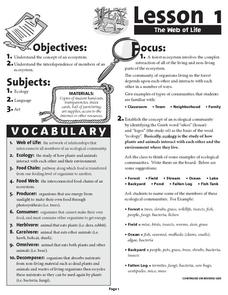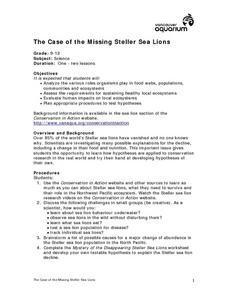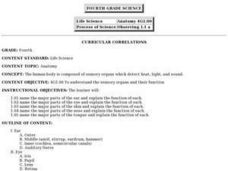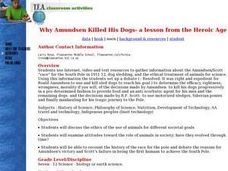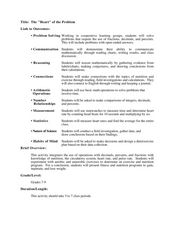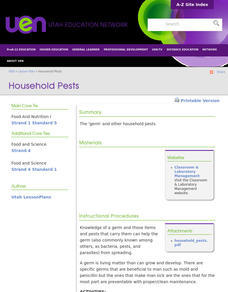Curated OER
Rosa Parks Community Garden
Ninth graders investigate how we depend on plants as the original source of most food. They investigate the parts of plants, and which parts are edible. Students are explained that the garden is also a classroom and the same rules apply.
Curated OER
Get the Skinny on Milk
Students identify the different types of milk available in the market. In this adult health science lesson, students compare their nutrition information. They read milk labels and analyze the nutrients in it.
Curated OER
Eggs, Baked Eggs Lab, Day 2
Students examine the structure, sizes and nutritional value of eggs. After completing a word search, they participate in a lab in which they make baked eggs with bacon. To end the instructional activity, they test their final product...
Curated OER
Eggs, Egg Test, Day 6
Students review their knowledge of eggs, their structure and nutritional value. After the test, they complete an egg lab and turn in their samples to the teacher. To end the lesson, they determine their egg score and discuss how many...
Curated OER
Mineral Munch
Second graders explore the sodium content in foods they eat. After observing a table setting, 2nd graders then identify items made from rock. They taste low sodium crackers and compare them to regular crackers. Students discuss the...
Curated OER
Coral Reefs Endangered
Pupils research where in the world coral reefs are located. In this ecology lesson, students create food chains and food web. They simulate growing coral reefs to understand their characteristics better.
Curated OER
Protein
Students examine protein, what it is and how it functions in the body. In this protein activity students study the food pyramid, what a protein is and what it does.
Curated OER
There Are Algae in Your House!
Young scholars demonstrate that, although we sometimes can neither smell nor taste them, many ingredients in our foods and household products come from the sea. They also investigate food eat to determine algae derivatives they contain.
Curated OER
The Web of Life
Young scholars participate in a game in which they discover the balance of life in the ocean. They identify different organisms that rely on different types of food. They answer questions to complete the lesson.
Curated OER
The Case of the Missing Steller Sea Lions
Students identify and analyze the various roles organisms play in food webs, populations, communities and ecosystems. Students assess the requirements for sustaining healthy local ecosystems. STudents evaluate human impacts on local...
Curated OER
Anatomy
Fifth graders identify and describe the functions of the major body systems. They discover how to maintain a healthy lifestyle with proper nutrition and exercise. They answer comprehension questions to end the lesson.
Curated OER
Someone Is In The Kitchen
Learners investigate the lifestyles of the Native Americans and look at a recipe found on a website. They read the recipe and pay attention to the measurements. They differentiate between the various measures in order to apply them to...
Curated OER
My Farm Web
Third graders explore agriculture by viewing video clips in class. In this farm animal activity, 3rd graders identify the animals mostly eaten that come from farms and the types of food they consume before they are eaten by us. Students...
Curated OER
Why Amundsen Killed His Dogs
Students use Internet, video and text resources to gather information about the Amundsen/Scott race for the South Pole in 1911-12, dog sledding, and the ethical treatment of animals for science. They set up a debate to determine the...
Curated OER
The Effects of the Calcium Ion on Cooked Dry Beans
Students investigate the effects of calcium ions on the quality characteristics of cooked dry beans. In this calcium ion and dry bean investigation lesson plan, students soak dry beans using 2 different soaking techniques and 2 different...
Curated OER
Fit With Fiber
Sixth graders investigate the nutritional value of different types of cereal. They take a survey of students that ate breakfast and create a circle graph with the results. Students examine the nutritional information on the sides of the...
Curated OER
The "Heart" of the Problem
Students create an exercise and nutrition program. In this interdisciplinary lesson, students use calculations of exercises plus their corresponding effects on the body and nutritional values of food to derive a health plan. Students...
Curated OER
Modifying Viscosity of Egg Yolk
Students investigate the effects of substances on the viscosity of egg yolks. In this viscosity lesson plan, students separate egg yolks from their albumen and then add different masses of albumen back to each egg yolk. They measure the...
Curated OER
Household Pests
Identify methods that prevent food-borne illnesses and contamination. National Standard 14.4.1 Identify food-borne illness Identify types of food-borne illness and their symptoms: botulism, e-coli, hepatitis, salmonella, staphylococci...
Curated OER
Eggs: A Practical Application
Apply food selection and preparation guidelines related to egg products. National Standard 14.3.3 Identify functions of eggs: binder, thickener, coating, leavening agent, emulsifier Identify egg cooking temperatures, techniques/methods:...
Curated OER
Quick Breads, Muffin Method Demo
Students learn what quick breads are and that they belong to the Bread, Cereal, Grain Food Group on the Food Guide Pyramid which are high in Carbohydrates. They identify characteristics to look for in quick bread products, the...
Curated OER
A Recipe for Reading: Asian Style Rice and Eggs
Learners read, write about, and cook with rice in this home economics lesson plan. They reflect on the experience eating rice at home or in other ethnic foods.
Curated OER
A World of Taste--Louisiana Gumbo
Students discover the multicultural contributions to New Orleans gumbo through participation in cross curriculum activities. In this multicultural diversity and New Orleans history lesson, students shade regions of a map according to a...
Curated OER
Healthy Eating
Students explore how they can make healthy food choices and assess how "eating healthy" requires knowledge and planning ahead. They review and discuss The Edible Pyramid as well before they complete this project online. Each student maps...










